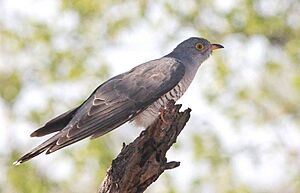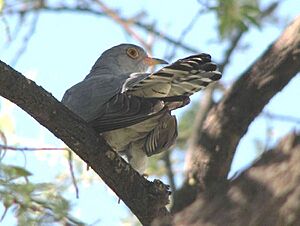African cuckoo facts for kids
Quick facts for kids African cuckoo |
|
|---|---|
 |
|
| Adult male in the Kruger National Park | |
| Conservation status | |
| Scientific classification | |
| Genus: |
Cuculus
|
| Species: |
gularis
|
The African cuckoo (Cuculus gularis) is a type of cuckoo bird. It is also called the African grey cuckoo. You can find this bird in Sub-Saharan Africa. It travels within the continent, usually arriving and breeding during the rainy season. This bird is quite common. The International Union for Conservation of Nature says it is a "least concern" species. This means it is not currently at risk of disappearing.
Contents
What the African Cuckoo Looks Like
This is a medium-sized bird with a long tail. It is about 32 centimeters (12.6 inches) long. When it flies quickly, it can look like a bird of prey.
Male and female African cuckoos look similar. Their heads, upper bodies, and wings are dark grey. Their throats and chests are pale grey. Their bellies are white with dark grey stripes. The tail is dark grey with dark stripes and a white tip.
The male cuckoo has yellow eyes. The female's eyes are light brown. Their beaks are yellow with black or horn-colored tips. Their legs and feet are yellowish.
Young cuckoos (juveniles) come in two color forms. The grey form is greyer than the adult, with white stripes. Its underside is creamy-white with many dark stripes. The brown form is brown instead of grey. Its white parts are replaced with buff or a reddish-brown color.
The male cuckoo's call sounds like "coo-coo." The second note is higher and louder. The female makes a bubbly sound like "Kwik-kwik-kwik."
Where African Cuckoos Live
The African cuckoo lives in many countries in Africa. These include Angola, Botswana, Kenya, South Africa, and Zambia. They travel to West Africa when the rainy season starts. They breed there and then leave. However, in some places like Nigeria, they seem to stay all year.
In East Africa, they also arrive with the rainy season. They might be there from October to May. In southern Africa, they are present from September to April.
Their favorite places to live are savannah areas. These are open grasslands with scattered acacia trees. They also like open woodlands. You won't find them in thick forests or very dry areas. They are fairly common but can be hard to spot unless they are calling.
How African Cuckoos Live
African cuckoos usually live alone. They find food in trees and on the ground. They search through leaves and even poke around in cattle dung. Their main food is caterpillars, both hairy and smooth ones. They also eat other insects like beetles and winged termites. They often perch almost straight up.
Male cuckoos protect their territory. In southern Africa, a pair of African cuckoos might have a territory larger than 60 hectares (148 acres). They will chase away other cuckoos.
Like many other cuckoos, the African cuckoo is a "brood parasite". This means the female lays her eggs in the nests of other bird species. She often removes an egg that is already in the nest. The types of host birds vary across different areas. The cuckoo's eggs usually look very similar in color and size to the host bird's eggs.
Common host birds include the yellow-billed shrike and the fork-tailed drongo. The cuckoo eggs hatch in about twelve to seventeen days, usually twelve. This is often before the host's eggs hatch. The cuckoo chick then pushes any other eggs or baby birds out of the nest. Its eyes open after eight days. It leaves the nest in three weeks but still relies on its foster parents for several more weeks.
In South Africa, up to 38 percent of cuckoo chicks successfully fledge. One time, yellow-billed shrike foster parents left their nest before the cuckoo chick could fly. They then built a new nest somewhere else. A study in Zambia showed that fork-tailed drongos often rejected African cuckoo eggs. The rejection rate was as high as 93.7%.
Conservation Status
The African cuckoo (C. gularis) is a common bird. It lives across a large area. No major threats have been found for this species. Its population is thought to be stable. Because of this, the International Union for Conservation of Nature has listed its conservation status as "least concern".




